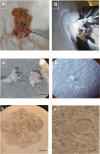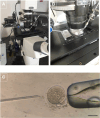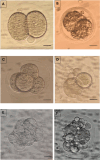Assessing the Impact of the Novel Sperm Selection Technique 'Annexin-V Coated Polystyrene Bead Technique' on Mouse Assisted Reproductive Techniques Outcomes: Preliminary Findings
- PMID: 38874899
- PMCID: PMC11393137
- DOI: 10.1007/s43032-024-01620-w
Assessing the Impact of the Novel Sperm Selection Technique 'Annexin-V Coated Polystyrene Bead Technique' on Mouse Assisted Reproductive Techniques Outcomes: Preliminary Findings
Abstract
ICSI is one of the most commonly used techniques to treat infertility. The sperm selection for the procedure is done 'randomly' by the embryologist according to the motility and morphology parameters which is known not to reflect the potential of a sperm for fertilization, pregnancy and a healthy childbearing. Since the apoptosis rate is higher in sperm cells of infertile patients, it is more likely to choose an apoptotic sperm by the 'random selection method'. We recently introduced a novel sperm selection technique namely 'Annexin-V coated polystrene bead technique'(APB-Tech), for the selection of non-apoptotic sperm cells. The principal of the technique is based on the binding affinity of an apoptotic sperm to 'Annexin-V covered beads' enabling to distinguish a viable and a healthy sperm by light microscopy. The aim of the present study was to observe the effects of this technique on ICSI outcomes in mice. Sibling-oocyte trial was conducted and the outcome measures were compared with the results of traditional sperm selection method. Embryo and blastocyst qualities and blastocyst development rates were significantly increased in APB-Tech group, while the other parameters were not affected. Promising results obtained from the technique reflect its promising potential as a new and powerful tool for sperm selection and thus infertility techniques.
Keywords: APB-Tech; Embryo; ICSI; Infertility; Sperm selection.
© 2024. The Author(s).
Conflict of interest statement
The authors declare no conflict of interest
Figures












Similar articles
-
Sperm selection with Annexin-V coated polystrene bead technique (APB-Tech): A novel and reliable method for the microscopic selection of viable and non-apoptotic sperm to be used for intracytoplasmic sperm injection.Theriogenology. 2022 Dec;194:92-103. doi: 10.1016/j.theriogenology.2022.09.028. Epub 2022 Sep 30. Theriogenology. 2022. PMID: 36209549
-
Selection of nonapoptotic spermatozoa as a new tool for enhancing assisted reproduction outcomes: an in vitro model.Biol Reprod. 2006 Mar;74(3):530-7. doi: 10.1095/biolreprod.105.046607. Epub 2005 Nov 23. Biol Reprod. 2006. PMID: 16306419
-
Removal of annexin V-positive sperm cells for intracytoplasmic sperm injection in ovum donation cycles does not improve reproductive outcome: a controlled and randomized trial in unselected males.Fertil Steril. 2014 Dec;102(6):1567-75.e1. doi: 10.1016/j.fertnstert.2014.09.001. Epub 2014 Oct 11. Fertil Steril. 2014. PMID: 25305728 Clinical Trial.
-
Improving ICSI: A review from the spermatozoon perspective.Syst Biol Reprod Med. 2016 Dec;62(6):359-371. doi: 10.1080/19396368.2016.1229365. Epub 2016 Sep 20. Syst Biol Reprod Med. 2016. PMID: 27646677 Review.
-
Sperm Selection for ICSI: Do We Have a Winner?Cells. 2021 Dec 17;10(12):3566. doi: 10.3390/cells10123566. Cells. 2021. PMID: 34944074 Free PMC article. Review.
References
-
- Rubino P, Viganò P, Luddi A, Piomboni P. The ICSI procedure from past to future: a systematic review of the more controversial aspects. Hum Reprod Update. 2016 Mar-Apr;22(2):194–227. - PubMed
-
- Berntsen S, Laivuori H, la Cour FN, Loft A, Söderström-Anttila V. B Oldereid N, Romundstad LB, Magnusson Å, Petzold M, Bergh C, Pinborg A. A systematic review and meta-analysis on the association between ICSI and chromosome abnormalities. Hum Reprod Update. 2021 Aug 20;27(5):801–47. 10.1093/humupd/dmab005 - DOI - PubMed
-
- Alberts B, Johnson A, Lewis J, et al. Molecular Biology of the Cell. In: Programmed Cell Death (Apoptosis). 4th ed. New York: Garland Science; 2002. Available from: https://www.ncbi.nlm.nih.gov/books/NBK26873/.
MeSH terms
Substances
Grants and funding
LinkOut - more resources
Full Text Sources

